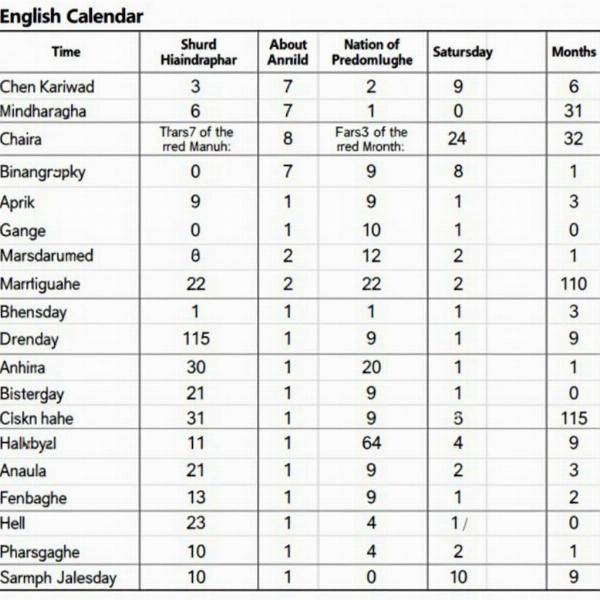Understanding the correspondence between Hindi and English month names is crucial for anyone navigating cultural exchanges, business dealings, or simply expanding their knowledge of the Indian calendar. This guide provides a clear and comprehensive overview of both Hindi and English month names, exploring their origins and cultural significance.
Navigating the Calendar: Hindi and English Month Equivalents
The Hindi calendar, primarily a lunisolar calendar, differs from the Gregorian calendar used in English-speaking countries. While both systems divide the year into twelve months, their starting points and durations vary. Let’s delve into the specifics of each month.
Chaitra (March-April): The Beginning of Spring
Chaitra, the first month of the Hindu calendar, marks the arrival of spring. It’s a time of renewal and celebration, often associated with the festival of Ram Navami.
Vaisakha (April-May): Festive Celebrations
Vaisakha is known for its vibrant festivals, including Buddha Purnima, commemorating the birth of Lord Buddha.
Jyeshtha (May-June): The Onset of Summer
Jyeshtha signifies the start of the summer season in India.
Ashadha (June-July): The Monsoon Season Arrives
Ashadha welcomes the much-awaited monsoon rains, vital for agriculture and bringing relief from the summer heat.
Shravana (July-August): A Month of Devotion
Shravana is a holy month dedicated to Lord Shiva, marked by fasting and religious observances.
Bhadrapada (August-September): Transitioning Seasons
Bhadrapada represents the transition between the monsoon and autumn seasons.
Ashvina (September-October): Autumn Festivities
Ashvina is filled with significant Hindu festivals, including Navratri and Dussehra.
Kartika (October-November): The Festival of Lights
Kartika is renowned for Diwali, the festival of lights, a major celebration across India.
Agrahayana (November-December): The Harvest Season
Agrahayana marks the harvest season, a time of prosperity and gratitude.
Pausha (December-January): The Winter Months
Pausha falls during the peak of winter in India.
Magha (January-February): Holy Bathing and Festivals
Magha is considered auspicious for holy bathing in rivers and is associated with the festival of Makar Sankranti.
Phalguna (February-March): The End of Winter
Phalguna signifies the end of winter and the beginning of the cycle anew.
 Hindi and English Month Names Comparison Table
Hindi and English Month Names Comparison Table
Why is understanding these differences important?
Knowing the correspondence between Hindi and English month names is essential for various practical reasons. It aids in scheduling events, understanding cultural references, and facilitating communication between individuals using different calendar systems. Imagine trying to plan a meeting or understanding a festival date without this knowledge. This guide helps bridge that gap.
Common Questions about Hindi and English Month Names
1. Are the Hindi month names always the same as the English months?
No, the Hindi calendar is lunisolar, while the Gregorian calendar is solar, leading to differences in their alignment.
2. Why do the Hindi months sometimes overlap two English months?
The difference in calendar systems causes this overlap, as the Hindi months are based on lunar cycles.
3. Are there any specific software or tools to convert between Hindi and English dates?
Yes, several online converters and calendar apps facilitate date conversion between different calendar systems.
4. Do all regions in India follow the same Hindi calendar?
While the core structure is similar, regional variations exist in the names and observances associated with the months.
5. What is the significance of the lunar cycle in the Hindi calendar?
The lunar cycle is fundamental to the Hindi calendar, influencing religious observances and festival dates.
6. How can I learn more about the cultural significance of each Hindi month?
Further research into Hindu festivals and traditions associated with each month can provide deeper insights.
7. Is it important to learn the Hindi month names even if I don’t speak Hindi?
Understanding the Hindi calendar provides valuable cultural context and can enhance interactions with Indian culture.
Connecting Hindi and English Through Meaning-Hindi.in
Navigating the nuances of different languages and cultures can be complex. Meaning-Hindi.in simplifies this process by offering expert translation services in various domains, including business, legal, technical, and educational materials. Our team of experienced linguists ensures accurate and culturally sensitive translations, bridging the communication gap between Hindi and English. For high-quality translation services, contact us at [email protected] or call us at +91 11-4502-7584. Meaning-Hindi.in is your trusted partner for all your Hindi-English translation needs.